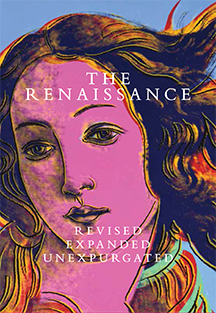Revising the Renaissance through a contemporary lens
By Daniel Aloi

A new book, “The Renaissance: Revised, Expanded, Unexpurgated” (Periscope), may change readers’ perceptions of the age of the Medici forever.
Edited by Cornell professor of architectural history D. Medina Lasansky, the book features essays on aspects of the Renaissance that remain resonant throughout popular culture, new media and tourism – from “The Da Vinci Code” to Las Vegas architecture.
Gathering new, previously unpublished research from experts in art, architecture, history and literature, the volume juxtaposes modern and classical art and explores the relationship between them.
This other Renaissance has great significance, whether seen on its own, or alongside the Renaissance of art historians, Lasansky argues. Focusing on both at once, the book provides new insight on issues ranging from the development of pornography to Italian food, political dissent to Michelangelo’s homosexuality.
“We’re trying to shake up the field of Renaissance studies; it’s so elitist and so stodgy and so male,” Lasansky said. “There are a lot of things that have never been discussed.”
Book launch, reception
The College of Architecture, Art and Planning (AAP) hosts a Mediterranean-themed reception, book launch and signing for “The Renaissance” Tuesday, Oct. 7, at 6:15 p.m., following an artist’s talk, “Book Books,” by book designer Adam Michaels at 5:15 p.m. in 157 E. Sibley Hall. Both are free and open to the public.
Michaels is a co-founder of Project Projects, a graphic design and art book firm. The firm’s work is on display at AAP through Oct. 17 in a collegewide digital exhibition.
Lasansky contributed three essays: “Sacred Graffiti,” on defacement as a devotional act; “Better Than Venice,” about the Venetian Las Vegas resort hotel modeled on an idealized Venice; and “The Art of Eating,” on the entirely modern phenomenon of Italy as a culinary attraction.
She began work on the book after a suggestion from one of her graduate students, Yael Manes, Ph.D. ’09, who also contributed an essay, “The Power of Mother’s Milk.” (Another former student, Sarah Benson, Ph.D. ’01, contributed “A Semester in Rome” and “Looking at Sex.”)
“The book would not have happened if it had not come out of a class,” Lasansky said. More recently, “one of my students said, ‘Why are you doing a book on the Renaissance? I thought you didn’t believe it existed.’ Well, it’s worth looking at in this way. … We need to interrogate how we teach the Renaissance. Most useful and exciting for me is how the students relate to this, and what it means to them. For example, how does it relate to video games?”
The book’s 129 illustrations include images of contemporary art never before related to the Renaissance, and well-known appropriations of classical art. The front cover shows Andy Warhol's “Detail from a Renaissance Painting” (1984), based on Botticelli’s “The Birth of Venus.”
“I dedicate it and owe it all to Andy,” said Lasansky, who collaborated with designer Adam Michaels and Periscope Publishing editor Gloria Kury on the book. “When we were in touch with the Warhol Foundation, they had approved this image, and they said, ‘We think it’s a project that Andy would have liked.’ I’ll take that.”
Lasansky’s scholarly interests include the relationship between politics, popular culture and the built environment. An award-winning author and scholar, her books include “The Renaissance Perfected: Architecture, Spectacle, and Tourism in Fascist Italy” (Penn State University Press, 2004) and, as co-editor, “Architecture and Tourism: Perception, Performance, and Place” (Berg, 2004).
Media Contact
Get Cornell news delivered right to your inbox.
Subscribe